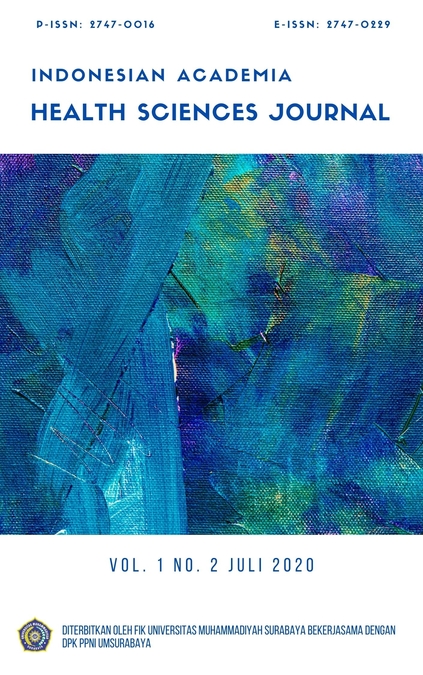Pengaruh Mobilisasi Progresif Terhadap Kejadian Dekubitus Pada Pasien Dengan Ventilasi Mekanik Di Ruang ICU RSD Mangusada
Abstract
ICU patients who are fitted with breathing equipped, especially mechanical ventilation, tend to have limited activity or immobilization. Long-term immobilization is a high risk factor that causes pressure ulcer. Appropriate prevention is needed because pressure ulcer has a detrimental impact on body functions and quality of life. This study aimed at identifying the effect of progressive mobilization on pressure ulcer incident in patient with mechanical ventilation in Intensive Care Unit at Mangusada Hospital.
Design of this study was Pre Experiment (one group pretest and posttest design) with the number of sample was 6 respondents which was chosen through Purposive Sampling technique. Instrument used in this study was a standard procedure of Richmond Agitation Sedation Scale (RASS) and observation sheet of Decubitus.
The result of the test indicated most of respondent experience grade I pressure ulcer (decubitus) before being given progressive mobilization therapy and after the therapy, all respondents (100%) did not showed pressure ulcer (decubitus) incident. Wilcoxon test showed that there was an effect of progressive mobilization on pressure ulcer incident in patient with mechanical ventilation in Intensive Care Unit at Mangusada Hospital (p-value = 0,042). Based on the results of this study, it is expected that this study can be used as an evidence based practice nursing, especially about pressure ulcer.Full text article
References
Bujang, B., Aini, F., & Purwaningsih, H. (2013). Pengaruh Alih Baring Terhadap Kejadian Dekubitus Pada Pasien Stroke Yang Mengalami Hemiparasis di Ruang Yudistira di RSUD Kota Semarang. Retrieved from https://docplayer.info/31995337-Pengaruh-alih-baring-terhadap-kejadian-dekubitus-pada-pasien-stroke-yang-mengalami-hemiparesis-di-ruang-yudistira-di-rsud-kota-semarang.html
European Pressure Ulcer Advisory Panel, & National Pressure Ulcer Advisory Panel. (2009). Pressure ulcer prevention and treatment clinical practice guidelines. 19–20. Retrieved from www.epuap.org/wp-content/.../final_quick_prevention.pdf
Hastuti, S., Nosi, H., & Bahar, B. (2013). Faktor-Faktor Yang Berhubungan Dengan Kejadian Dekubitus Pada Pasien Di Ruang Intensive Care Unit Rumah Sakit Ibnu Sina Makassar. 2, 39–45.
Irawan. (2010). Hubungan Lama Hari Rawat Dengan Terjadinya Dekubitus Pada Paien Yang Dirawat di Ruang ICU RSUP dr. H. Soemarno Sosroatmodjo Kuala Kapuas Banjarmasin.
Musliha. (2010). Keperawatan Gawat Darurat. Yogyakarta: Nuha Medika.
National Pressure Ulcer Advisory Panel. (2014). Prevention and Treatment of Pressure Ulcers : Quick Reference Guide. In Clinical Practice Guideline.
Ningtyas, N. W. ., Pujiastuti, R. S. ., & Indriyawati, N. (2019). Effectiveness Of Progressive Mobilization Level I And Ii On Hemodynamic Status And Decubitus Ulcer Risk In Critically Ill Patients. Belitung Nursing Journal, 3(6), 662–669.
Potter & Perry. (2013). Fundamental keperawatan. Jakarta: Salemba Medika.
Sunatrio. (2010). Penentuan mati pengakhiran resusitasi dan euthanasia pasif di ICU. Retrieved May 3, 2019
Tayyib, N., Coyer, F., & Lewis, P. (2013). Pressure ulcers in the adult intensive care unit: a literature review of patient risk factors and risk assessment scales. Journal of Nursing Education and Practice, 3(11), 28–42. https://doi.org/10.5430/jnep.v3n11p28
Zakiyyah, S. (2014). Pengaruh Mobilisasi Progresif Level I Terhadap Risiko Dekubitus Dan Perubahan Saturasi Oksigen Pada Pasien Kritis Terpasang Ventilator Di Ruang Icu RSUD Dr. Moewardi Surakarta. Universitas Diponegoro.
Zomorodi, M., & Darla Topley, andMaireMcAnaw C. (2012). Developing aMobility Protocol for EarlyMobilization of Patients in a Surgical/Trauma ICU. Critical Care Research and Practice, 1(5), 1–10.
Zulaikah, S. P. K. dan S. eko C. P. (2015). Pengaruh Alih Baring 2 Jam Terhadap Resiko Dekubitus Dengan Varian Berat Badan Pada Pasien Bedrest Total Di SMC RS telogorejo. Ilmu Keperawatan Dan Kebidanan, 29–36.

